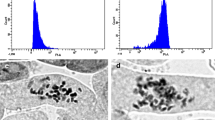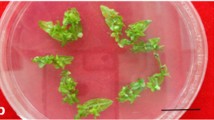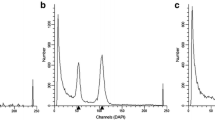Abstract
Tetraploid plants have been produced from nineZantedeschia cultivars usingin vitro colchicine treatment. Rapidly-multiplying shoot cultures were treated on a medium containing 0.05% colchicine for 1, 2 or 4 days to induce chromosome doubling. Following the treatment, most shoots were killed but the surviving shoots were multiplied for several subcultures. These shoots were then rootedin vitro and transferred to a greenhouse. Plants were screened 2 months later by measuring stomatal length, and 110 out of 565 plants were selected as putative tetraploids with a stomatal length significantly greater than in diploid control plants. Chromosome counts were carried out on root tips from 44 plants and confirmed that 38 were tetraploids, 2 were chimeras (predominantly tetraploid with a few octoploid cells), and 4 were diploids. Stomatal length has been rechecked in mature tetraploid plants of the cultivar Black Magic, demonstrating that stomatal length is a good indicator of ploidy level inZantedeschia. This study has shown that multiplying colchicine-treated shootsin vitro for several subcultures prior to transfer to soil produced very few chimeras. The stomatal length measurements are non-destructive and allow the rapid screening of a population for tetraploids.
Similar content being viewed by others
Abbreviations
- BA:
-
benzyladenine
- SD:
-
standard deviation
References
Ackerman WL & Dermen H (1972) A fertile colchiploid from a sterile interspecific camellia hybrid. J. Hered. 63: 55–59
Anderson JA, Mousset-Declas C, Williams EG & Taylor NL (1991) Anin vitro chromosome doubling method for clovers (Trifolium spp.). Genome 34:1–5
Barnabas B, Pfahler PL & Kovacs G (1991) Direct effect of colchicine on the microspore embryogenesis to produce dihaploid plants in wheat (Triticum aestivum L.). Theor. Appl. Genet. 81: 675–678
Bingham ET (1968) Stomatal chloroplasts in alfalfa at four ploidy levels. Crop Sci. 8: 509–510
Borrino EM & Powell W (1988) Stomatal guard cell length as an indicator of ploidy in microspore-derived plants of barley. Genome 30:158–160
Chaudhari HK & Barrow JR (1975) Identification of cotton haploids by stomatal chloroplast-count technique. Crop Sci. 15: 760–762
Chavadej S & Becker H (1984) Influence of colchicine treatment on chromosome number and growth rate of tissue cultures ofValeriana wallichii DC. Plant Cell Tiss. Org. Cult. 3: 265–272
Chen CH & Goeden-Kallemeyn Y (1979)In vitro induction of tetraploid plants from colchicine-treated diploid daylily callus. Euphytica 28: 705–709
Cohen D (1981) Micropropagation ofZantedeschia hybrids. International Propagator's Society Combined Proceedings For 1981 31: 312–316
Dolezel J & Binarova P (1989) The effects of colchicine on ploidy level, morphology and embryogenic capacity of alfalfa suspension cultures. Plant Sci. 64: 213–219
Gmitter Jr. FG, Ling X, Cai C & Grosser JW (1991) Colchicine-induced polyploidy inCitrus. embryogenic cultures, somatic embryos, and regenerated plantlets. Plant Sci. 74: 135–141
Griesbach RJ (1990) Colchicine-induced polyploidy inEustoma grandiflorum. Hort-Science 25: 1284–1286
Heinz DJ & Mee GWP (1970) Colchicine induced polyploids from cell suspension cultures of sugarcane, Crop Sci. 10: 696–699
Johnston SA, den Nijs TPM, Peloquin SJ & Hanneman Jr. RE (1980) The significance of genetic balance to endosperm development in interspecific crosses. Theor. Appl. Genet. 57: 5–9
Kamo K & Griesbach RJ (1989) Determination of ploidy level in ‘Mitchell’ Petunias. Plant Sci. 65: 119–124
Lyrene PM & Perry JL (1982) Production and selection of blueberry polyploidsin vitro. J. Hered. 73: 377–378
Murashige T & Nakano R (1966) Tissue culture as a potential tool in obtaining polyploid plants. J. Hered. 57: 114–118
Orton TJ & Steidl RP (1980) Cytogenetic analysis of plants regenerated from colchicine-treated callus cultures of an interspecificHordeum hybrid. Theor. Appl. Genet. 57: 89–95
Przywara L, Pandey KK & Sanders PM (1988) Length of stomata as an indicator of ploidy level inActinidia deliciosa. New Zealand J. Bot. 26: 179–182
Schifino MT & Fernandes MIM (1987) Induction of polyploidy and cytological characterization of autotetraploids ofTrifolium riograndense Burkart (Leguminosae). Euphytica 36: 863–872
Tan GY & Dunn GM (1973) Relationship of stomatal length and frequency and pollen grain diameter to ploidy level inBromus inermis Leyss. Crop Sci. 13: 332–334
Van Tuyl JM, Van Dien MP, Van Criej MGM, Van Kleinwee J, Franken J & Bino RJ (1991) Application ofin vitro pollination, ovary culture, ovule culture and embryo rescue for overcoming incongruity barriers in interspecificLilium crosses. Plant Sci. 74: 115–126
Yao JL, Cohen D & Rowland RE (1994a) Karyotype studies in the genusZantedeschia. S. Afr. J. Bot. 60: 4–7
Yao JL, Cohen D & Rowland RE (1994b) Plastid DNA inheritance and plastome genome incompatibility in interspecific hybrids ofZantedeschia (Araceae). Theor. Appl. Genet. 88: 255–260
Yao JL, Cohen D & Rowland RE (1995) Interspecific albino and variegated hybrids in the genusZantedeschia. Plant Sci. 109: 199–206
Author information
Authors and Affiliations
Corresponding author
Rights and permissions
About this article
Cite this article
Cohen, D., Yao, JL. In vitro chromosome doubling of nineZantedeschia cultivars. Plant Cell Tiss Organ Cult 47, 43–49 (1996). https://doi.org/10.1007/BF02318964
Received:
Accepted:
Issue Date:
DOI: https://doi.org/10.1007/BF02318964




